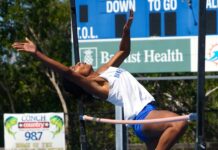Locals adjust to changing markets, regulations, weather
Gary Graves said it was mackerel, but Bennett Orr swears it was mullet. The two Marathon men have an ongoing argument about the type of fish served at the first Marathon Seafood Festival 39 years ago. Both agree either would be a hard sell at the 2015 festival this weekend (see sidebar).
“Mullet’s great. Up around Lake Okeechobee it’s considered a delicacy,” Orr said, “But I can’t imaging trying to serve it to today’s crowds. They like the mahi mahi.”
The mullet and mackerel are just one example of the many changes commercial fishing has undergone since the 1950s. The changes have many causes — what the market demands, what government allows and the type of technology or tools that can make it happen.
In the 1950s, Marathon had six major fish houses. (Now, there’s one: Keys Fisheries is the number one processor of stone crab and lobster in the state). On the gulfside there was Leo Cooper’s City Fish and East Coast Fisheries. East Coast Fisheries also had a fish house on the oceanside of the island, next to Elmer Aldacosta’s Marathon Seafood and Pinellas Seafood.
In the late ’40s, commercial fishing consisted of net fishing for mackerel and trout and lobstering. (The old metal ice cans were the “casitas” of choice.) It wasn’t until the late 1940s that the Key West Pink Shrimp boom began, lasting about three decades. In the 1950s, a survey associated with a federal permit to dredge Boot Key Harbor counted 300 to 500 commercial fishing boats, 200 to 300 pleasure boats and 12 to 15 charters in Boot Key Harbor. Many of the boats home-ported on the mainland, but plied Keys’ waters for the best haul. Some commercial fishermen piloted boats owned by the fish house, others had their own craft. But nobody went fishing unless the price was good enough to bother.
The nation’s interest in stone crab, and Marathon’s economic gains, came later. Orr credits Marathon’s Tim Daniels with spreading the word.
“He’s largely responsible for the success of the stone crab. He put so much effort into that fishery; he was the mouthpiece,” Orr said.
Daniels said he and his cousin Bubba Daniels and uncle Godfrey Daniels were the first in the Keys to target stone crab. And they could catch more crab than the fish houses could sell.
“We fished only one, or two, or three days a week,” he said. “The fish houses told us to hold off until they could sell what they had.”
It wasn’t until Irwin Sawitz and Dick Remedey of Joe’s Stone Crab on Miami Beach left a message for Daniels that things really started to move. Sawitz said he could buy all the stone crab they could catch … to which Daniels replied he needed a fish house. In 1967, Keys Fisheries was born. Each of the three Daniels, the fourth generation of commercial fishermen, fished between 2,000 and 4,000 traps a piece.
Along with Marathon’s growing commercial fishing industry in the 1950s and 1960s, came the satellite businesses. Elmer Aldacosta’s brother opened a fish restaurant. Marathon attorney Frank Greenman’s father purchased a boat works from Chet Tingler and improved upon it.
“My dad was a retired Naval architect,” Greenman said. “The pilings he built for the docks are still in good shape today.”
Marathon Boat Works had a huge lift, capable of hauling big shrimp boats and room to work on multiple boats at one time. Greenman said one time a 300-foot destroyer ran aground near Sombrero Reef and bent a shaft. Marathon Boat Works was able to replace it. Unfortunately, it wasn’t strong enough to survive the very strong Category 3 storm Hurricane Donna in 1960.
“It killed the shrimping industry. It just up and moved to Texas,” Greenman said. “And it affected our business badly, too. We stayed alive for a few more years by doing contract work for the U.S. government boats that ran guns and people to Cuba in the lead up to the Bay of Pigs.”
Greenman said the family left for the space coast not long after. And he returned 10 years later to teach at Marathon High School.
By the 1970s, most commercial fishermen in the Florida Keys concentrated on catches of lobster and stone crab. In those days, lobster paid about 35 cents a pound. Many of today’s commercial fishermen started in the business with nothing more than a strong set of lungs.
“We’d dive for lobsters and groupers and stuff. We did some of it around Duck Key and would sell it to Indies Inn, now Hawks Cay Resort. And they would serve it fresh to their guests. Of course, you can’t do that anymore without a wholesale retail license,” said Paul Lebo, president of the Marathon chapter of Organized Fishermen of Florida.
Eventually, Lebo acquired his own boat and own traps.
“And now I have more than I want,” he said, laughing.
Little by little, commercial seafood has been regulated. There’s a slew of licenses and permits and tags needed to harvest and sell the bounty of the sea. And over the years the technology has improved the efficiency of the catch.
The Middle Keys are still a thriving commercial fishing zone. The fishermen engage in back-breaking work and the profit margin is always threatened by more than our fair share of hurricanes (knock wood). They must also pay special attention to the sustainability of the fisheries and actively partner with the government agencies to ensure they can continue to deliver the products the whole country adores.

























